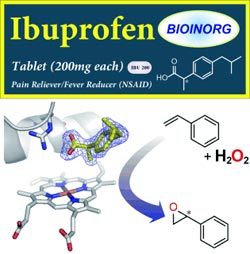Ibuprofen Decoy

<br>
Enzymes can be efficient biocatalysts for organic synthesis, but often only work on a small range of specific substrates.
Yoshihito Watanabe and colleagues at Nagoya University and RIKEN (Japan) have tricked enzymes into catalyzing reactions between molecules of choice, they report in Chemistry—An Asian Journal. By using organic acids, including the pain reliever ibuprofen, they mimicked the natural substrate.
The researchers used one member of the family of so-called cytochrome P450 enzymes, which owe their catalytic activity to the same heme group that binds oxygen in hemoglobin in the blood. They were able to expand its substrate scope by using organic acids to simulate substrate binding. The carboxylic acid group activates the H2O2 oxidant, which finally results in oxidation of the heme iron atom and generation of the active species.
This “decoy” approach allows epoxidation of styrene, which cannot normally be achieved with P450 enzymes. When an asymmetric decoy is used, such as the common pain reliever ibuprofen, the epoxidation proceeds stereoselectively: Only the desired molecule is produced, but not its mirror image, which can make the difference between a drug and a poison.
Further optimization of the system both in terms of decoy molecule and P450 mutant should yield higher catalytic activity and better stereoselectivity. This method should prove valuable in expanding the use of enzymes in organic synthesis.
About the Author
Dr. Yoshihito Watanabe is Vice President of Nagoya University and Professor at the Research Center for Materials Science there. His research concentrates on metalloenyzmes for catalysis.
Author: Yoshihito Watanabe, Nagoya University (Japan), http://bioinorg.chem.nagoya-u.ac.jp/
Title: Chiral-Substrate-Assisted Stereoselective Epoxidation Catalyzed by H2O2-Dependent Cytochrome P450SPá
Chemistry – An Asian Journal, Permalink to the article: http://dx.doi.org/10.1002/asia.201200250
Media Contact
All latest news from the category: Life Sciences and Chemistry
Articles and reports from the Life Sciences and chemistry area deal with applied and basic research into modern biology, chemistry and human medicine.
Valuable information can be found on a range of life sciences fields including bacteriology, biochemistry, bionics, bioinformatics, biophysics, biotechnology, genetics, geobotany, human biology, marine biology, microbiology, molecular biology, cellular biology, zoology, bioinorganic chemistry, microchemistry and environmental chemistry.
Newest articles

High-energy-density aqueous battery based on halogen multi-electron transfer
Traditional non-aqueous lithium-ion batteries have a high energy density, but their safety is compromised due to the flammable organic electrolytes they utilize. Aqueous batteries use water as the solvent for…

First-ever combined heart pump and pig kidney transplant
…gives new hope to patient with terminal illness. Surgeons at NYU Langone Health performed the first-ever combined mechanical heart pump and gene-edited pig kidney transplant surgery in a 54-year-old woman…

Biophysics: Testing how well biomarkers work
LMU researchers have developed a method to determine how reliably target proteins can be labeled using super-resolution fluorescence microscopy. Modern microscopy techniques make it possible to examine the inner workings…





















